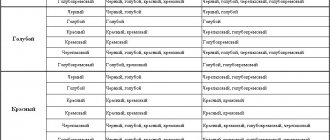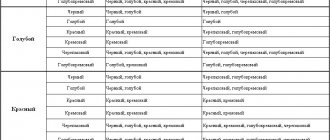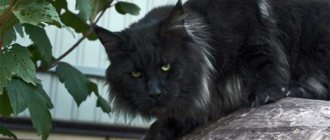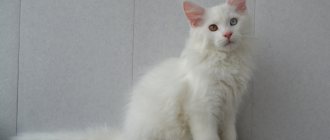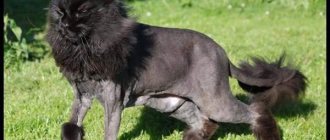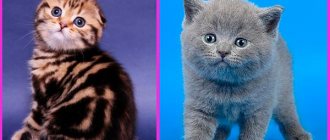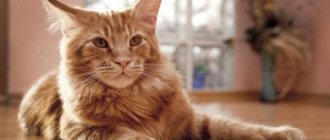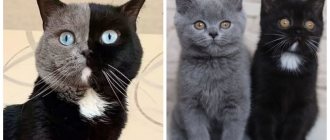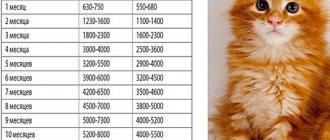Numbers and letters in color designation
MSO is the breed itself - Maine Coon . The lowercase w represents the color of the coat. There are many colors and therefore these letters are different. Here are the main notations:
- W – white – white;
- N – black – black;
- A - blue - blue;
- D – red – red;
- E – cream – cream;
- F – tortoiseshell – tortoiseshell;
- G – blue-cream – bluetortie.
When the breed description contains only one of the above letters, it means that the coat has a uniform, solid Maine Coon color. The combination of letters, on the contrary, indicates uneven coloring of the hair.
The designation of patterns on a Maine Coon is made by the very numbers that come after the letter combination. In our case, 22 are marble shades: eye rims, streaks on the sides, stripes along the ridge, streaks on the paws and tail.
23 – Maine Coon brindle color. The pattern will have vertical stripes, similar to a mackerel or tiger.
24 – broken stripes and white spots, etc.
Having looked at the variety of combinations, let's turn to the main types of Maine Coon colors that are most often found.
Color classification
All colors of Maine Coon cats can be divided into categories: with a pattern or tabby; without a pattern or solid; tortoiseshell; smoky and silver.
Drawing (tabby)
The Maine Coon Tabby has the following traits:
- stripes on the forehead in the shape of the letter "M"
- eyes and nose mirror are outlined in dark
- there are dark stripes on the sides of the muzzle
- stripes on the chest form a “necklace”
- horizontal stripes on paws
- small spots on the belly
The drawing itself comes in 4 types:
- Marble or classic (blotched/classic). There are rounded marks on the sides; a “butterfly” is possible between the shoulder blades. And solid lines along the spine.
- Tiger (mackerel). There are solid vertical stripes on the sides and a dark stripe along the spine.
- Spotted. Pattern in the form of small spots or dotted stripes.
- Ticked. The drawing is only on the face. Each hair ends in a dark color. The ticked color of Man-Coons is not typical and is typical of Oriental breeds.
People often use the name “wild” or “forest”. Underneath is the black marbled color of the Maine Coon n22.
n 22 – black marbled tabby
n 23 09 – black brindle tabby with white
d 24 – red spotted tabby
a 25 – blue ticked tabby
Solid (solid)
A solid colored cat should have a uniform color throughout the body. Breed standards assume that the coat color is rich and the hairs are dyed from base to tip. The disadvantage is the residual pattern, including on the head, as well as a lighter undercoat (than the main color). Markings of a different color are considered defective.
In Maine Coons, solid is represented by 5 colors:
- Black
- Red
- White
- Blue
- Cream
Some colors are not allowed in the breed standard. The unrecognized colors of the Maine Coon are: gold, chocolate, cinnamon, fawn, lilac and color point.
The black Maine Coon cat has a stunning look. It needs to be combed more often than others. This way, fur renewal occurs faster and dead brown hairs do not remain. This is especially true during the molting period. For a healthy and beautiful coat, you need to provide your pet with proper nutrition. Maine Coons with a black coat are the most difficult to prepare for a show. Dead hairs are brownish in color, while new ones are gray, which darkens over time. You need to make sure that the wool in the collar area and on the “pants” does not have a different color cast.
If a Maine Coon is born black with a white spot, then it is already a bicolor color.
n – black solid
The red color of the Maine Coon includes all shades. Most often you can hear the name red Maine Coon. Due to the strong tabby gene, it is very difficult to achieve the absence of a pattern in a Red Maine Coon. Therefore, it is slightly visible, but still present in the solid.
d – red solid
You can't go past the luxurious white Maine Coon cat. As stated earlier, this color is not a color. This is rather a lack of color in the Maine Coon, because the hair does not have color pigment. A small kitten may have color markings on its face that fade over time. Pets are not fussy to care for. White Maine Coons come with blue eyes and multi-colored eyes (one is blue and the other is green). The completely green iris of the eyes is characteristic of the silver color (description below). It is worth noting that such kittens have a risk of being born deaf. Therefore, it is better to choose a snow-white miracle from experienced breeders: crossing two white individuals is prohibited.
w 62 – white with yellow eyes
Maine Coons of the blue solid color are not very common in the CIS countries. Their fur is ash-gray in color, with a certain blue tint. Probably because of him, blue Maine Coons became popular in Europe.
a – blue solid
The cream Maine Coon is obtained by lightening the red color. The color has warm shades of ginger. Achieving pure colors is problematic due to the progression of classical genes in the Maine Coon.
e – creamy solid
Tortoiseshell
There is an opinion that cats with a combination of several colors bring good luck. A black tortoiseshell Maine Coon can be a torby or a tortie depending on the number of colors. Torbi includes red and black (brown). Torti adds cream color. The lightened classic tortoiseshell coloring is called blue-cream.
Interesting! Most cats are born with tortoiseshell coloration. The chance of having a boy is 1 in 1000.
Tortoiseshell cats can be additionally smoky or silver.
f 22 – black tortoiseshell marbled tabby
g – blue-cream tortoiseshell solid
In addition, the color may be missing or have white markings of varying sizes. A Maine Coon with white spots that have distinct edges is called a calico. Translated as “chintz” or “flap”. Calicos are characterized by the presence of red spots with a pattern. Blue-cream Maine Coons, with a spotted pattern or diluted calico (calico) may also have white markings.
f 09 – black solid turtle with white
Silver and smoke
Smoky Maine Coons always produce an impressive effect. A distinctive feature of the color is the presence of a perfectly white root zone in the coat. Do not go with a lightened or grayish color.
Smoky coloring has its own categories:
- normal – hair is half dyed
- shaded – the hair is colored by a quarter
- chinchilla – one-eighth of the hair is dyed
Black Smoke Maine Coons, like Blue Smoke, have a rich base color along with white roots. Tortoiseshell can also be smoky.
ns – black smoke
If a cat with a white undercoat has a pattern, then this color is called silver. As a rule, such kittens are born very light. As they grow older, the fur begins to darken and the pattern becomes brighter. Coloring is determined at a young age by eye color. The silver color has green eyes, and the blue color has white eyes.
fs 22 – black silver tortoiseshell marbled tabby
In red smoke (silver) kittens, the coat pigment is weakly visible. They are born light-colored, which is why they are called “cream” or “cameo.”
ds 23 – red silver (cameo) brindle tabby
White spots
White spots can be in addition to the main color. Depending on the size and location, the division occurs:
- Van is an almost white individual with several spots on the head and tail, and occasionally on the body.
- Harlequin - Larger spots of color are located on the main white background.
- Bicolor (bi-color) – the ratio of white and main color is 50/50.
- Locket - a white spot located on the chest.
- Gloves (mitted) – white spots on the ends of the paws, as if wearing “socks”.
- Tuxedo (tuxedo) – white spots are located on the chest and paws, possibly on the head.
- Buttons – several small white spots.
n 03 – black and white bicolor
n 01 – black and white van
In conclusion, we can say that Maine Coons do not have rare colors. Even a red Maine Coon or a black merle can be rare if they are unique based on the coloring of their parents. You also need to understand that the same color will look different on two kittens.
Tabby Maine Coon
Maine Coon colors are called tabby if there are stripes on the animal's coat. They are certainly present on the muzzle, circling the eye sockets and forming the letter M on the forehead. A careful examination reveals that the stripes alternate (light and dark). This combination is called agouti.
There are three main tabby patterns:
- Brindle . The strips are arranged parallel to each other in a vertical position;
- Classic . Stripes similar to marble stains are on the sides. They are wide and spiral;
- Spotted . The Maine Coon's body is covered with intermittent stripes in the form of spots.
Some experts also classify the Abyssinian pattern as a tabby. When there are no stripes or spots on the body, but there is a pattern on the face.
Tabbies come in a variety of colors, the color of the stripes and the tip of the tail being important. The hue of agouti, in turn, varies from pale blue to rich red.
What you need to know about color point color
Color point – light body and dark tail, ears, paws and muzzle. Moles are usually born completely light-colored, and their dark spots appear as they grow older.
Tabby and color point colors are not typical for dogs. Here it is customary to distinguish the following types of coat colors:
1. Basic
: black, blue, brown, beige, sand, red, white.
2. Combined
: red with a mask and sandy with a mask, red with blackening and sandy with blackening, black and tan color with variations, red brindle and sandy brindle, red sable with variations.
3. Modified
: graying, marbled, spotted.
To preserve the intensity of color, you need to follow a special diet and monitor the correct diet. Also, loss of color intensity may indicate an illness. To rule out illness, consult your veterinarian.
Solid Maine Coons (black, white)
When a Maine Coon's color consists of only one color, it is called solid. This color is produced by suppressing recessive genes. If the pattern is not completely suppressed, leaving a fuzzy shadow tabby.
Cream and red colors do not effectively suppress tabbies. Maine Coons of this color will certainly have patterns on their body, to one degree or another.
The monochromatic white color is obtained due to the influence of various genes that can suppress colors. White kittens often have shades of stripes on their heads in the first months of life. This is explained by incomplete suppression of color. But with age everything goes away.
“Caramelization” is a lightening modifier gene
In the 70s of the 20th century, the breeder of Orientals and Siamese Patricia Turner
When working with point and silver groups, I received kittens with new colors, which on the one hand were a little similar to the classic lightened ones (blue, lilac, fawn), on the other hand they were different from them.
Evaluation of pedigrees and experimental matings suggested that there is a new gene influencing the base color. Its effect was manifested only in those who had already bleached, for which it received the name bleaching modifier gene
.
It is located in another locus of the chromosome, therefore, in the presence of a dominant clarifier gene (genotype DD, Dd), it does not manifest itself. Animals with the lightening modifier gene always have a “caramel” color
and cannot be its carrier, since only its dominant variant appears.
Blue becomes gray or dark gray with a brown coating, chocolate becomes almost dark brown, cloudy (taupe color), lilac becomes coffee with milk, cream becomes hot apricot. Solid cats look a little dusty, while tabbies acquire a metallic sheen. The lightening modifier gene is designated Dm
. The recessive form dm has no effect on color. Like the lightening gene, the modifier affects the shape and arrangement of pigment particles in the hair. It is most common in cats of the eastern group, but recently it has begun to appear in other cultivated breeds.
aaBBdd/Bbdd/Bb'dd
(blue) ⟶
aaBBddDm/BbddDm/Bb'ddDm
(caramel based on blue)
aabbdd/bb'dd
(lilac) ⟶
aabbddDm/bb'ddDm
(taupe)
aab'b'dd
(faun) ⟶
aab'b'ddDm
(caramel based on faun)
aaOOdd/OOdd/oodd
(cream) ⟶
aaOOddDm/OoddDM/ooddDm
(apricot)
Maine Coon smoke
If a Maine Coon cat is blue or black in color, but the roots of the hairs are white, it is called smoke. If the cats are monochromatic, their hair roots will be grayish. True smoky animals have white roots.
This Maine Coon color always smacks of mystery and is distinguished by its iridescent coat color.
In addition to blue and black smoke, you can also find the following varieties:
- Chinchillas - an eighth of the hair has color;
- Shaded – the hair is colored by a quarter;
- Silver – at birth, Maine Coon kittens appear white in color, but over time they acquire a shade of silver. A sure sign of such animals are green eyes;
- Cream, red smoky. At birth, Maine Coon kittens also have a white coat color, which changes with age.
"Smoky" beauties
“Smoky” cats look very impressive, especially when their shiny, well-groomed fur sways and shimmers in the light. The smoky color is due to the fact that the root of each cat’s hair is white, and the end is colored, and with different intensities. For example, in a Maine Coon, black smoke has a strong base color.
In international coding, this sign is marked with the Latin letter S, which, depending on the interpretation, can mean smoke (smoke) or silver (silver). According to the degree of hair coloring, smokiness is divided into the following categories:
- regular smoke - half the hair is dyed;
- shaded smoke - a quarter of the hair is dyed;
- chinchilla – one-eighth of the hair is dyed.
color blue smoke
color red smoke
color black smoke
Exquisite Silver
The silver coon stands somewhat apart in this gradation. This is such a light coat color that it is very difficult to distinguish it from white, especially in childhood. A silver Maine Coon kitten is usually identified by the color of its iris: a white Maine most likely has blue eyes, and a silver Maine has green eyes. Over time, the silver coat darkens a little, and a pattern called “tabby” (discussed below) becomes more pronounced on it. Cats of this color are generally very attractive and unusual, but the so-called “marble on silver” looks especially elegant, when wide spiral stripes are run along the silvery fur, reminiscent of marble patterns.
color silver tabby
color tortoiseshell silver bicolor
color red silver
Color with white markings
The white markings of the Maine Coon are visible quite clearly, and not as in the case of the shaded version. The spots are located differently and vary in size. This determines their exact color names. Highlight:
- with a white medallion (spot on the chest);
- with white gloves (stains on paws);
- with white buttons (if there are several stains);
- harlequin (colored spots on a white coat);
- tuxedo (white paws and chest);
- bicolor (half white).
Multicolored
The colors that are considered lucky by the people are called tortoiseshell or patterned tabby in the felinological community. They come with or without white spots of varying coverage areas. A pure tortoiseshell has colored markings (except white) arranged in a chaotic manner.
The brown spotted Maine Coon tabby is a combination of red and brown. It can be distinguished by its saturation. Diluted tortoiseshell - blue cream. Features pastel shades. The blue spotted tabby is easily recognized by its low intensity and the presence of blue and cream colors.
If a coon has white spots, then most likely there is a calico mark in the pedigree. Translated, this term means “flap”, “chintz”. In cats, the edges of the spots are clearly defined. Calicos are characterized by red markings with a pattern on their fur.
Coons can also have marks:
- Blue cream with white; Diluted calico or chintz; Spotted tabby with white.
Each of the listed points has its own characteristics. As a rule, a tortoiseshell cat is born very rarely. For about 1000 kittens, there is only one male. Numerous myths are associated with this, but almost all cats of this color are not capable of producing offspring. This does not affect cats.
Tortoiseshell Maine Coon and tabby patterned
It often happens that the Maine Coon breed has completely random combinations of colors and shades. Then the color can be called:
- Tortoiseshell - spots of various colors and sizes are scattered all over the cat’s body, with the exception of white: black, red, cream;
- Tabby spotted brown is like falling leaves in the fall. Numerous areas of brown and red color on the Maine Coon's body. The color is also called torbie;
- Blue-cream . The body of the Maine Coon is covered with spots of pastel colors. They have blue and cream shades. This color is also called blue turtle;
- Blue spotted tabby . It is a delicate color with patches of blue and cream tabby.
Unrecognized colors
Maine Coons of chocolate, gold, lilac, Siamese or any combination thereof are often not allowed to show.
There are also restrictions on the nature of coloring: colors and patterns that are found in Asian breeds are not recognized in raccoon cats. These include fawn, sorrel, cinnamon, point color, as well as any acromelanic colors. It is believed that oriental blood spoils the massive and powerful backbone of the Maine Coon. Ticked tabbies are also prohibited from showing.
Ticked Maine Coon
Maine Coon ticked color Breeders are diligently developing more and more new colors. Whether it's black markings on silver or blue markings next to white and tan spots, the famous wild colors will turn the Maine Coon into a real star of the show catwalk.
The Maine Coon breed truly delights with its variety of colors. Don't forget to help your pet properly care for its coat so that it always looks truly regal!
Are random combinations possible?
All possible combinations of Maine Coon colors are determined by the genetics of the parental pairs. Cats can be latent carriers of various genes, which is why their offspring often produce kittens that are different from their parents. To obtain the desired color of the offspring, it is necessary to study the pedigree of the producers. Then there will be no unpleasant surprises among the colors of the kittens.
When breeding Maine Coons, you should not get offspring from 2 completely white cats. Kittens born from such matings often have abnormalities that are incompatible with life.
If the kitten is completely white and has blue eyes, it should be checked for deafness, because... The gene for white spotting in cats is linked to deafness, which is inherited. Cats with heterochromia may be deaf in the ear that is on the same side as the blue eye.
Tortoiseshell is considered a random color in cats. This color is normally characteristic only of cats, because... linked to the X chromosome. It appears rarely in cats - due to a genetic failure (the presence of an additional X chromosome) or chimerism (a phenomenon in which 1 embryo develops from 2 zygotes).
Golden coloring exists in the breed, but is not recognized by all felinological associations. Maine Coons of tabby and chinchilla colors can be golden. At the same time, their main tone remains standard, and the undercoat and background of patterned colors have an apricot or golden color.
The appearance of kittens of colors prohibited by the Breed Standard indicates hybridization of producers with representatives of other breeds. Such animals should be excluded from the breeding program.
From a genetic point of view, Maine Coons have two main coat colors – red and black. All other shades are different variations of the basic ones. All the variety of colors and patterns appears due to the special distribution of hair pigment, which determines the color of the animal.
Determining the hereditary color allows you to find out which cat's offspring will appear. Maine Coons are no exception here. To do this, breeders use special tables with formulas that will tell the color of future kittens. Based on them, you can decide how to cross the adults to get the desired result.
Maine Coons of different shades.
